Associated British Foods: Operations and Project Management Report
VerifiedAdded on 2021/02/19
|17
|4528
|20
Report
AI Summary
This report delves into the realm of operations and project management, using Associated British Foods (AB Foods) as a case study. It begins with an overview of operations management, exploring its principles such as accountability, change, quality control, and reality, and their application within AB Foods. The report then transitions to a continuous improvement plan (CIP), focusing on lean manufacturing principles like value, value stream mapping, flow, pull, and perfection, tailored for AB Foods. The CIP addresses cost, quality, safety, and delivery aspects, recommending methodologies like Six Sigma, TQM, and Just-in-Time. The report further applies project life cycle (PLC) to a Portakabin project, including a business case, work breakdown structure, Gantt chart, and discussion of project methodologies. It concludes with an analysis of the effectiveness of the PLC and the incorporation of cost-saving and quality techniques.
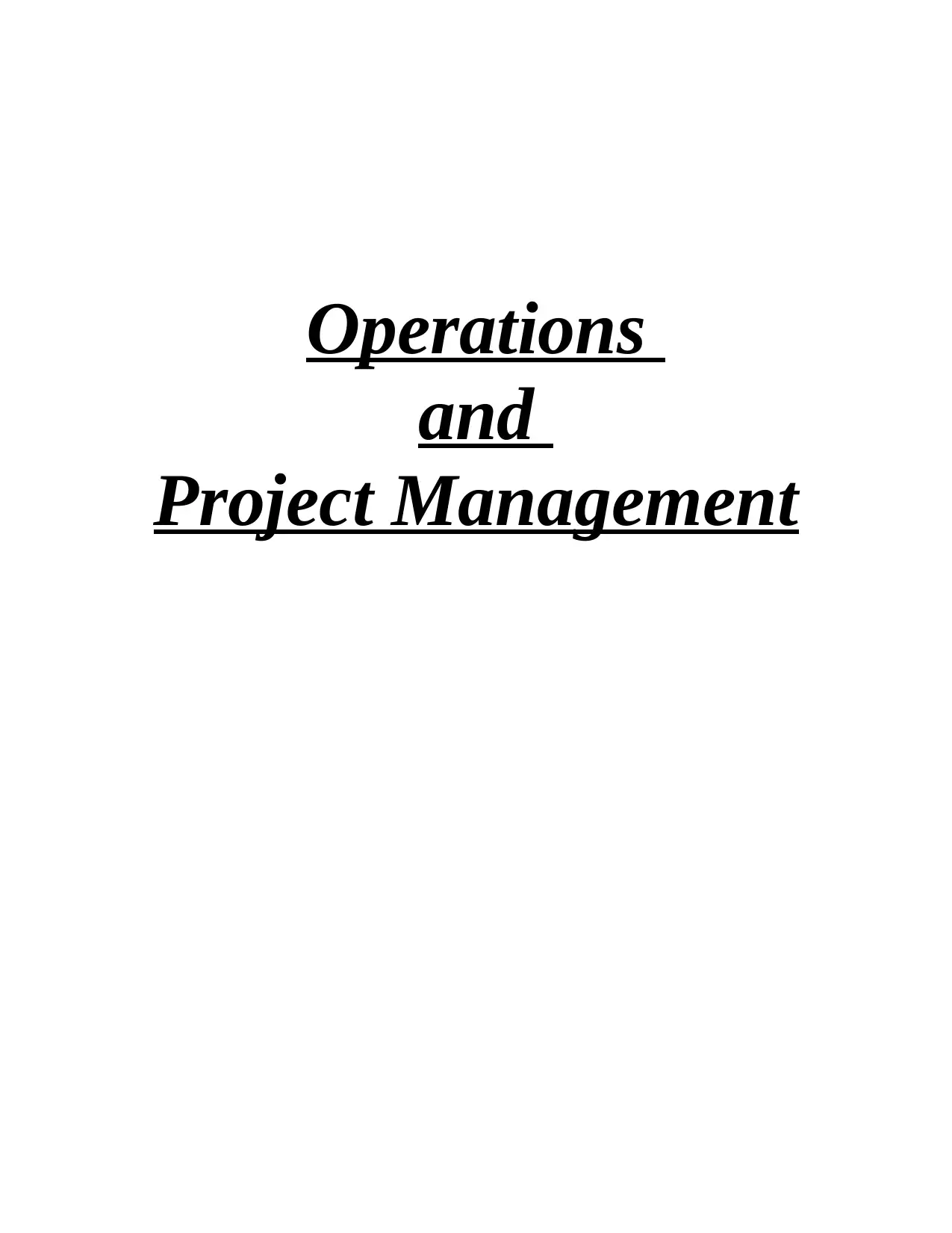
Operations
and
Project Management
and
Project Management
Paraphrase This Document
Need a fresh take? Get an instant paraphrase of this document with our AI Paraphraser
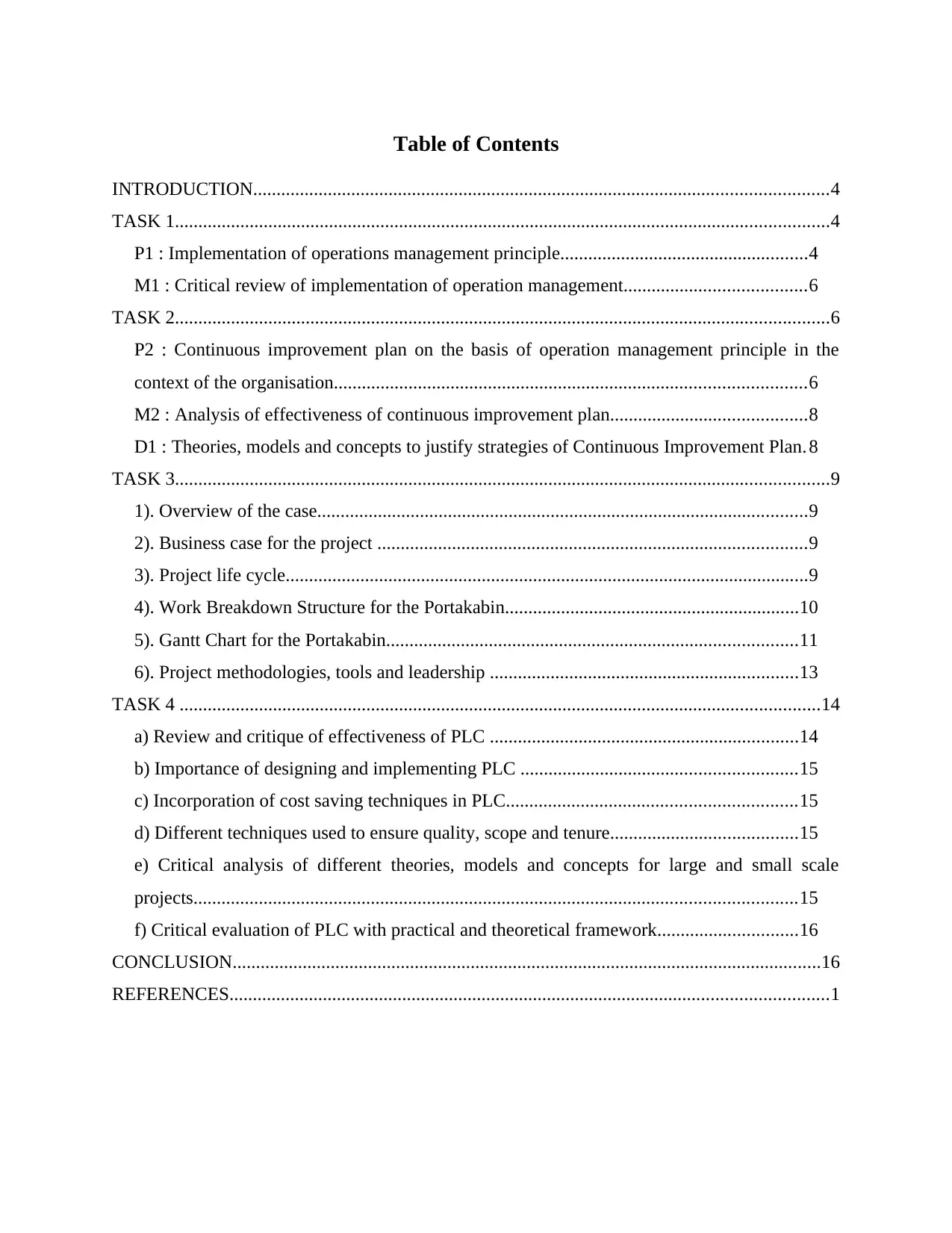
Table of Contents
INTRODUCTION...........................................................................................................................4
TASK 1............................................................................................................................................4
P1 : Implementation of operations management principle.....................................................4
M1 : Critical review of implementation of operation management.......................................6
TASK 2............................................................................................................................................6
P2 : Continuous improvement plan on the basis of operation management principle in the
context of the organisation.....................................................................................................6
M2 : Analysis of effectiveness of continuous improvement plan..........................................8
D1 : Theories, models and concepts to justify strategies of Continuous Improvement Plan. 8
TASK 3............................................................................................................................................9
1). Overview of the case.........................................................................................................9
2). Business case for the project ............................................................................................9
3). Project life cycle................................................................................................................9
4). Work Breakdown Structure for the Portakabin...............................................................10
5). Gantt Chart for the Portakabin........................................................................................11
6). Project methodologies, tools and leadership ..................................................................13
TASK 4 .........................................................................................................................................14
a) Review and critique of effectiveness of PLC ..................................................................14
b) Importance of designing and implementing PLC ...........................................................15
c) Incorporation of cost saving techniques in PLC..............................................................15
d) Different techniques used to ensure quality, scope and tenure........................................15
e) Critical analysis of different theories, models and concepts for large and small scale
projects.................................................................................................................................15
f) Critical evaluation of PLC with practical and theoretical framework..............................16
CONCLUSION..............................................................................................................................16
REFERENCES................................................................................................................................1
INTRODUCTION...........................................................................................................................4
TASK 1............................................................................................................................................4
P1 : Implementation of operations management principle.....................................................4
M1 : Critical review of implementation of operation management.......................................6
TASK 2............................................................................................................................................6
P2 : Continuous improvement plan on the basis of operation management principle in the
context of the organisation.....................................................................................................6
M2 : Analysis of effectiveness of continuous improvement plan..........................................8
D1 : Theories, models and concepts to justify strategies of Continuous Improvement Plan. 8
TASK 3............................................................................................................................................9
1). Overview of the case.........................................................................................................9
2). Business case for the project ............................................................................................9
3). Project life cycle................................................................................................................9
4). Work Breakdown Structure for the Portakabin...............................................................10
5). Gantt Chart for the Portakabin........................................................................................11
6). Project methodologies, tools and leadership ..................................................................13
TASK 4 .........................................................................................................................................14
a) Review and critique of effectiveness of PLC ..................................................................14
b) Importance of designing and implementing PLC ...........................................................15
c) Incorporation of cost saving techniques in PLC..............................................................15
d) Different techniques used to ensure quality, scope and tenure........................................15
e) Critical analysis of different theories, models and concepts for large and small scale
projects.................................................................................................................................15
f) Critical evaluation of PLC with practical and theoretical framework..............................16
CONCLUSION..............................................................................................................................16
REFERENCES................................................................................................................................1

⊘ This is a preview!⊘
Do you want full access?
Subscribe today to unlock all pages.

Trusted by 1+ million students worldwide
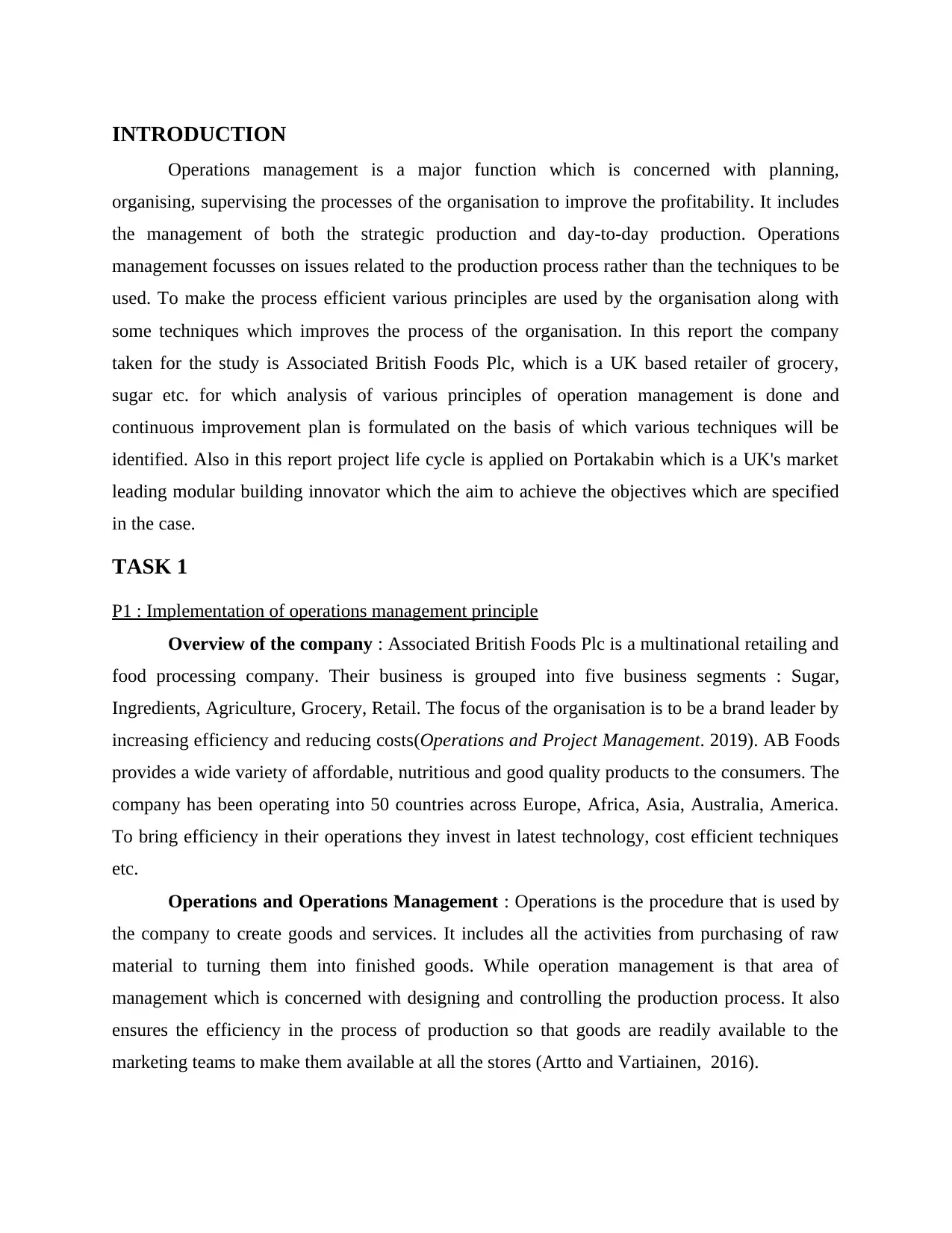
INTRODUCTION
Operations management is a major function which is concerned with planning,
organising, supervising the processes of the organisation to improve the profitability. It includes
the management of both the strategic production and day-to-day production. Operations
management focusses on issues related to the production process rather than the techniques to be
used. To make the process efficient various principles are used by the organisation along with
some techniques which improves the process of the organisation. In this report the company
taken for the study is Associated British Foods Plc, which is a UK based retailer of grocery,
sugar etc. for which analysis of various principles of operation management is done and
continuous improvement plan is formulated on the basis of which various techniques will be
identified. Also in this report project life cycle is applied on Portakabin which is a UK's market
leading modular building innovator which the aim to achieve the objectives which are specified
in the case.
TASK 1
P1 : Implementation of operations management principle
Overview of the company : Associated British Foods Plc is a multinational retailing and
food processing company. Their business is grouped into five business segments : Sugar,
Ingredients, Agriculture, Grocery, Retail. The focus of the organisation is to be a brand leader by
increasing efficiency and reducing costs(Operations and Project Management. 2019). AB Foods
provides a wide variety of affordable, nutritious and good quality products to the consumers. The
company has been operating into 50 countries across Europe, Africa, Asia, Australia, America.
To bring efficiency in their operations they invest in latest technology, cost efficient techniques
etc.
Operations and Operations Management : Operations is the procedure that is used by
the company to create goods and services. It includes all the activities from purchasing of raw
material to turning them into finished goods. While operation management is that area of
management which is concerned with designing and controlling the production process. It also
ensures the efficiency in the process of production so that goods are readily available to the
marketing teams to make them available at all the stores (Artto and Vartiainen, 2016).
Operations management is a major function which is concerned with planning,
organising, supervising the processes of the organisation to improve the profitability. It includes
the management of both the strategic production and day-to-day production. Operations
management focusses on issues related to the production process rather than the techniques to be
used. To make the process efficient various principles are used by the organisation along with
some techniques which improves the process of the organisation. In this report the company
taken for the study is Associated British Foods Plc, which is a UK based retailer of grocery,
sugar etc. for which analysis of various principles of operation management is done and
continuous improvement plan is formulated on the basis of which various techniques will be
identified. Also in this report project life cycle is applied on Portakabin which is a UK's market
leading modular building innovator which the aim to achieve the objectives which are specified
in the case.
TASK 1
P1 : Implementation of operations management principle
Overview of the company : Associated British Foods Plc is a multinational retailing and
food processing company. Their business is grouped into five business segments : Sugar,
Ingredients, Agriculture, Grocery, Retail. The focus of the organisation is to be a brand leader by
increasing efficiency and reducing costs(Operations and Project Management. 2019). AB Foods
provides a wide variety of affordable, nutritious and good quality products to the consumers. The
company has been operating into 50 countries across Europe, Africa, Asia, Australia, America.
To bring efficiency in their operations they invest in latest technology, cost efficient techniques
etc.
Operations and Operations Management : Operations is the procedure that is used by
the company to create goods and services. It includes all the activities from purchasing of raw
material to turning them into finished goods. While operation management is that area of
management which is concerned with designing and controlling the production process. It also
ensures the efficiency in the process of production so that goods are readily available to the
marketing teams to make them available at all the stores (Artto and Vartiainen, 2016).
Paraphrase This Document
Need a fresh take? Get an instant paraphrase of this document with our AI Paraphraser
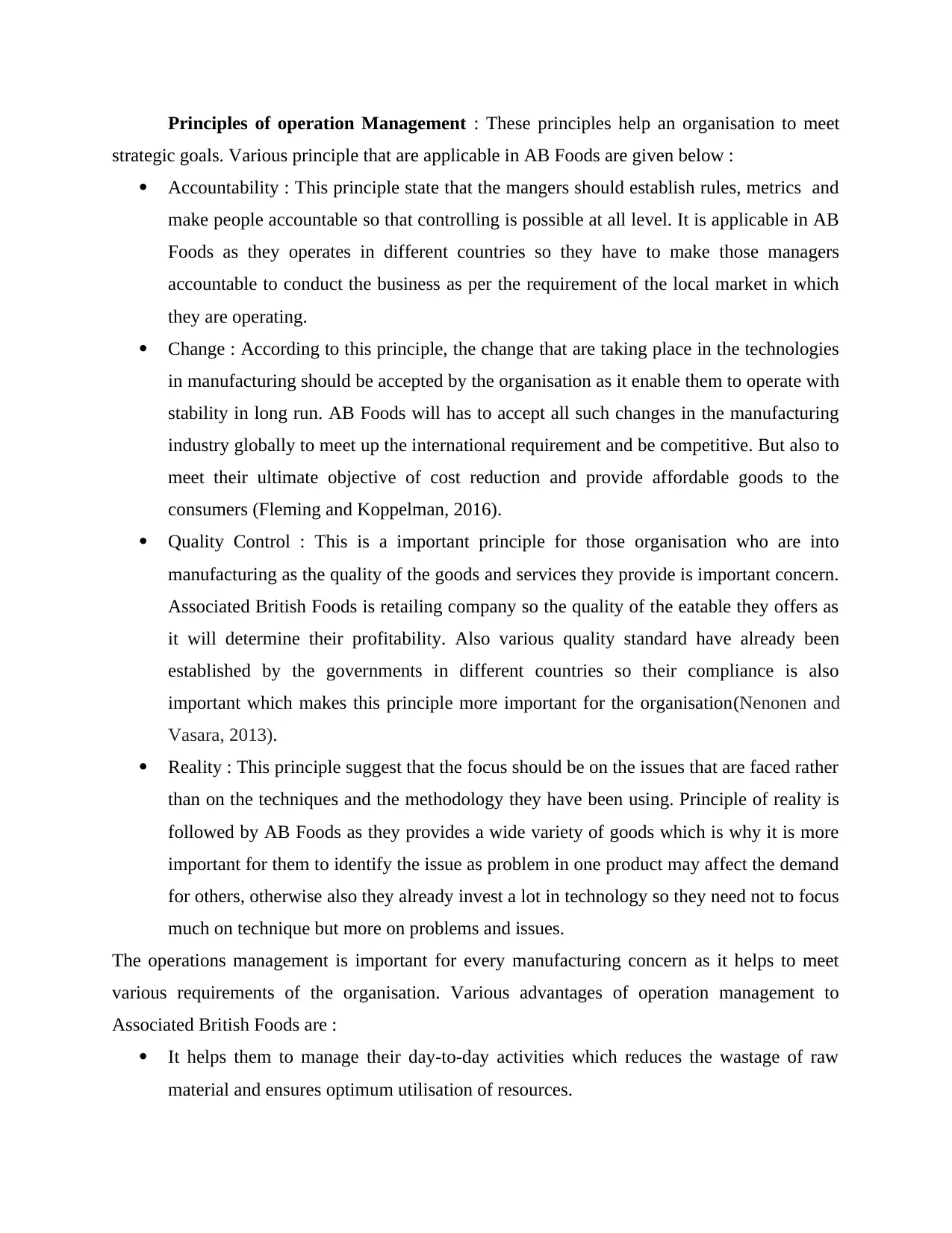
Principles of operation Management : These principles help an organisation to meet
strategic goals. Various principle that are applicable in AB Foods are given below :
Accountability : This principle state that the mangers should establish rules, metrics and
make people accountable so that controlling is possible at all level. It is applicable in AB
Foods as they operates in different countries so they have to make those managers
accountable to conduct the business as per the requirement of the local market in which
they are operating.
Change : According to this principle, the change that are taking place in the technologies
in manufacturing should be accepted by the organisation as it enable them to operate with
stability in long run. AB Foods will has to accept all such changes in the manufacturing
industry globally to meet up the international requirement and be competitive. But also to
meet their ultimate objective of cost reduction and provide affordable goods to the
consumers (Fleming and Koppelman, 2016).
Quality Control : This is a important principle for those organisation who are into
manufacturing as the quality of the goods and services they provide is important concern.
Associated British Foods is retailing company so the quality of the eatable they offers as
it will determine their profitability. Also various quality standard have already been
established by the governments in different countries so their compliance is also
important which makes this principle more important for the organisation(Nenonen and
Vasara, 2013).
Reality : This principle suggest that the focus should be on the issues that are faced rather
than on the techniques and the methodology they have been using. Principle of reality is
followed by AB Foods as they provides a wide variety of goods which is why it is more
important for them to identify the issue as problem in one product may affect the demand
for others, otherwise also they already invest a lot in technology so they need not to focus
much on technique but more on problems and issues.
The operations management is important for every manufacturing concern as it helps to meet
various requirements of the organisation. Various advantages of operation management to
Associated British Foods are :
It helps them to manage their day-to-day activities which reduces the wastage of raw
material and ensures optimum utilisation of resources.
strategic goals. Various principle that are applicable in AB Foods are given below :
Accountability : This principle state that the mangers should establish rules, metrics and
make people accountable so that controlling is possible at all level. It is applicable in AB
Foods as they operates in different countries so they have to make those managers
accountable to conduct the business as per the requirement of the local market in which
they are operating.
Change : According to this principle, the change that are taking place in the technologies
in manufacturing should be accepted by the organisation as it enable them to operate with
stability in long run. AB Foods will has to accept all such changes in the manufacturing
industry globally to meet up the international requirement and be competitive. But also to
meet their ultimate objective of cost reduction and provide affordable goods to the
consumers (Fleming and Koppelman, 2016).
Quality Control : This is a important principle for those organisation who are into
manufacturing as the quality of the goods and services they provide is important concern.
Associated British Foods is retailing company so the quality of the eatable they offers as
it will determine their profitability. Also various quality standard have already been
established by the governments in different countries so their compliance is also
important which makes this principle more important for the organisation(Nenonen and
Vasara, 2013).
Reality : This principle suggest that the focus should be on the issues that are faced rather
than on the techniques and the methodology they have been using. Principle of reality is
followed by AB Foods as they provides a wide variety of goods which is why it is more
important for them to identify the issue as problem in one product may affect the demand
for others, otherwise also they already invest a lot in technology so they need not to focus
much on technique but more on problems and issues.
The operations management is important for every manufacturing concern as it helps to meet
various requirements of the organisation. Various advantages of operation management to
Associated British Foods are :
It helps them to manage their day-to-day activities which reduces the wastage of raw
material and ensures optimum utilisation of resources.
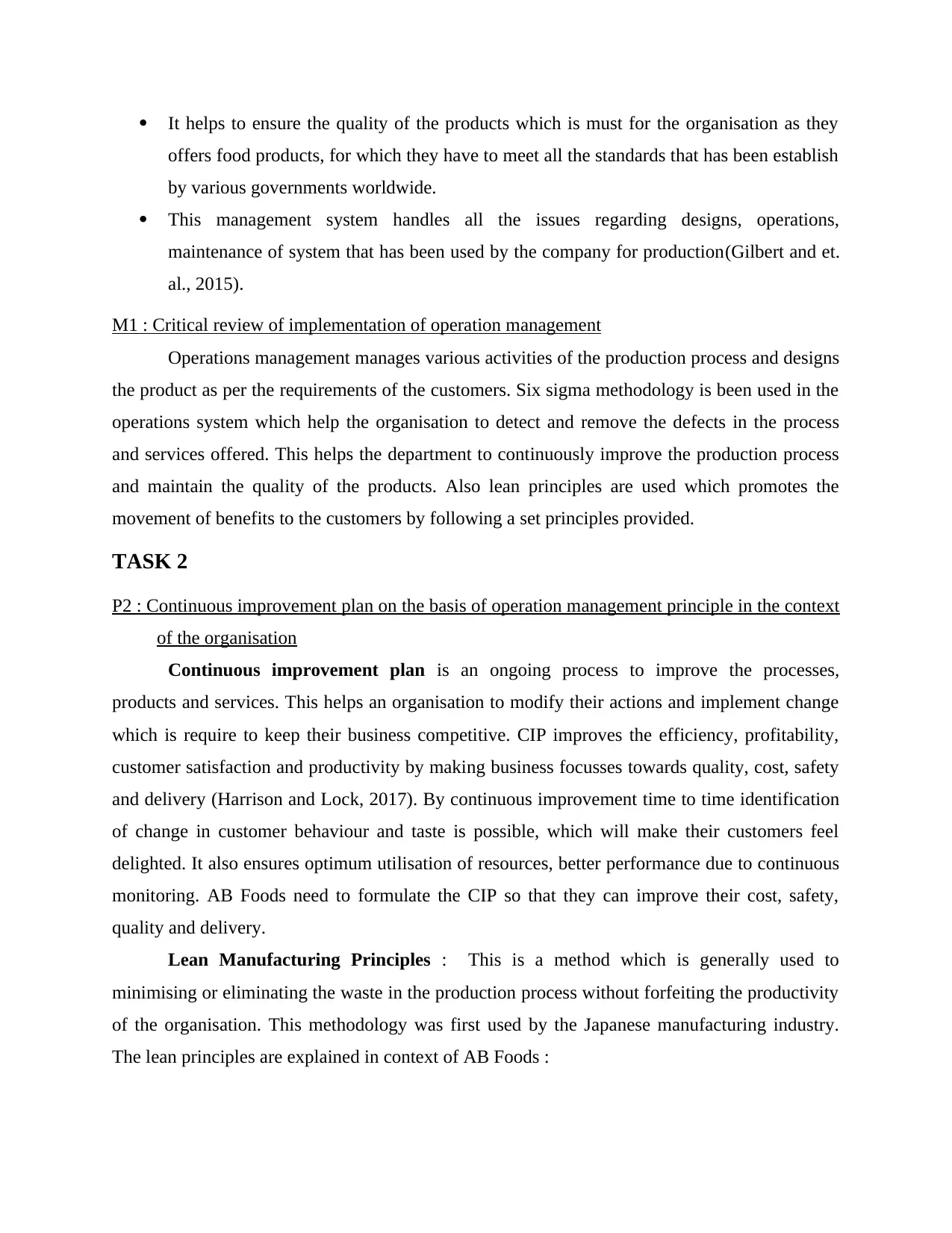
It helps to ensure the quality of the products which is must for the organisation as they
offers food products, for which they have to meet all the standards that has been establish
by various governments worldwide.
This management system handles all the issues regarding designs, operations,
maintenance of system that has been used by the company for production(Gilbert and et.
al., 2015).
M1 : Critical review of implementation of operation management
Operations management manages various activities of the production process and designs
the product as per the requirements of the customers. Six sigma methodology is been used in the
operations system which help the organisation to detect and remove the defects in the process
and services offered. This helps the department to continuously improve the production process
and maintain the quality of the products. Also lean principles are used which promotes the
movement of benefits to the customers by following a set principles provided.
TASK 2
P2 : Continuous improvement plan on the basis of operation management principle in the context
of the organisation
Continuous improvement plan is an ongoing process to improve the processes,
products and services. This helps an organisation to modify their actions and implement change
which is require to keep their business competitive. CIP improves the efficiency, profitability,
customer satisfaction and productivity by making business focusses towards quality, cost, safety
and delivery (Harrison and Lock, 2017). By continuous improvement time to time identification
of change in customer behaviour and taste is possible, which will make their customers feel
delighted. It also ensures optimum utilisation of resources, better performance due to continuous
monitoring. AB Foods need to formulate the CIP so that they can improve their cost, safety,
quality and delivery.
Lean Manufacturing Principles : This is a method which is generally used to
minimising or eliminating the waste in the production process without forfeiting the productivity
of the organisation. This methodology was first used by the Japanese manufacturing industry.
The lean principles are explained in context of AB Foods :
offers food products, for which they have to meet all the standards that has been establish
by various governments worldwide.
This management system handles all the issues regarding designs, operations,
maintenance of system that has been used by the company for production(Gilbert and et.
al., 2015).
M1 : Critical review of implementation of operation management
Operations management manages various activities of the production process and designs
the product as per the requirements of the customers. Six sigma methodology is been used in the
operations system which help the organisation to detect and remove the defects in the process
and services offered. This helps the department to continuously improve the production process
and maintain the quality of the products. Also lean principles are used which promotes the
movement of benefits to the customers by following a set principles provided.
TASK 2
P2 : Continuous improvement plan on the basis of operation management principle in the context
of the organisation
Continuous improvement plan is an ongoing process to improve the processes,
products and services. This helps an organisation to modify their actions and implement change
which is require to keep their business competitive. CIP improves the efficiency, profitability,
customer satisfaction and productivity by making business focusses towards quality, cost, safety
and delivery (Harrison and Lock, 2017). By continuous improvement time to time identification
of change in customer behaviour and taste is possible, which will make their customers feel
delighted. It also ensures optimum utilisation of resources, better performance due to continuous
monitoring. AB Foods need to formulate the CIP so that they can improve their cost, safety,
quality and delivery.
Lean Manufacturing Principles : This is a method which is generally used to
minimising or eliminating the waste in the production process without forfeiting the productivity
of the organisation. This methodology was first used by the Japanese manufacturing industry.
The lean principles are explained in context of AB Foods :
⊘ This is a preview!⊘
Do you want full access?
Subscribe today to unlock all pages.

Trusted by 1+ million students worldwide
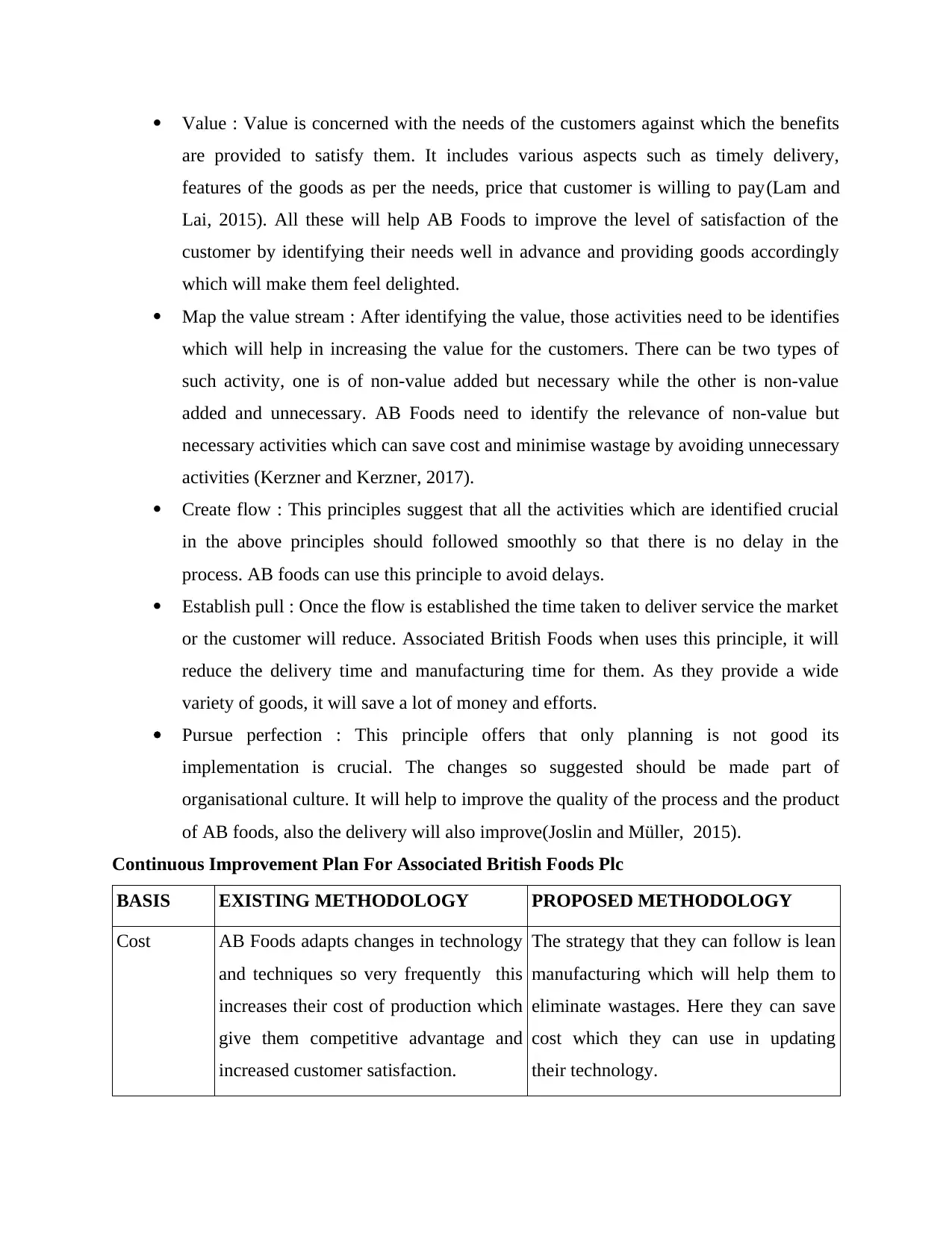
Value : Value is concerned with the needs of the customers against which the benefits
are provided to satisfy them. It includes various aspects such as timely delivery,
features of the goods as per the needs, price that customer is willing to pay(Lam and
Lai, 2015). All these will help AB Foods to improve the level of satisfaction of the
customer by identifying their needs well in advance and providing goods accordingly
which will make them feel delighted.
Map the value stream : After identifying the value, those activities need to be identifies
which will help in increasing the value for the customers. There can be two types of
such activity, one is of non-value added but necessary while the other is non-value
added and unnecessary. AB Foods need to identify the relevance of non-value but
necessary activities which can save cost and minimise wastage by avoiding unnecessary
activities (Kerzner and Kerzner, 2017).
Create flow : This principles suggest that all the activities which are identified crucial
in the above principles should followed smoothly so that there is no delay in the
process. AB foods can use this principle to avoid delays.
Establish pull : Once the flow is established the time taken to deliver service the market
or the customer will reduce. Associated British Foods when uses this principle, it will
reduce the delivery time and manufacturing time for them. As they provide a wide
variety of goods, it will save a lot of money and efforts.
Pursue perfection : This principle offers that only planning is not good its
implementation is crucial. The changes so suggested should be made part of
organisational culture. It will help to improve the quality of the process and the product
of AB foods, also the delivery will also improve(Joslin and Müller, 2015).
Continuous Improvement Plan For Associated British Foods Plc
BASIS EXISTING METHODOLOGY PROPOSED METHODOLOGY
Cost AB Foods adapts changes in technology
and techniques so very frequently this
increases their cost of production which
give them competitive advantage and
increased customer satisfaction.
The strategy that they can follow is lean
manufacturing which will help them to
eliminate wastages. Here they can save
cost which they can use in updating
their technology.
are provided to satisfy them. It includes various aspects such as timely delivery,
features of the goods as per the needs, price that customer is willing to pay(Lam and
Lai, 2015). All these will help AB Foods to improve the level of satisfaction of the
customer by identifying their needs well in advance and providing goods accordingly
which will make them feel delighted.
Map the value stream : After identifying the value, those activities need to be identifies
which will help in increasing the value for the customers. There can be two types of
such activity, one is of non-value added but necessary while the other is non-value
added and unnecessary. AB Foods need to identify the relevance of non-value but
necessary activities which can save cost and minimise wastage by avoiding unnecessary
activities (Kerzner and Kerzner, 2017).
Create flow : This principles suggest that all the activities which are identified crucial
in the above principles should followed smoothly so that there is no delay in the
process. AB foods can use this principle to avoid delays.
Establish pull : Once the flow is established the time taken to deliver service the market
or the customer will reduce. Associated British Foods when uses this principle, it will
reduce the delivery time and manufacturing time for them. As they provide a wide
variety of goods, it will save a lot of money and efforts.
Pursue perfection : This principle offers that only planning is not good its
implementation is crucial. The changes so suggested should be made part of
organisational culture. It will help to improve the quality of the process and the product
of AB foods, also the delivery will also improve(Joslin and Müller, 2015).
Continuous Improvement Plan For Associated British Foods Plc
BASIS EXISTING METHODOLOGY PROPOSED METHODOLOGY
Cost AB Foods adapts changes in technology
and techniques so very frequently this
increases their cost of production which
give them competitive advantage and
increased customer satisfaction.
The strategy that they can follow is lean
manufacturing which will help them to
eliminate wastages. Here they can save
cost which they can use in updating
their technology.
Paraphrase This Document
Need a fresh take? Get an instant paraphrase of this document with our AI Paraphraser
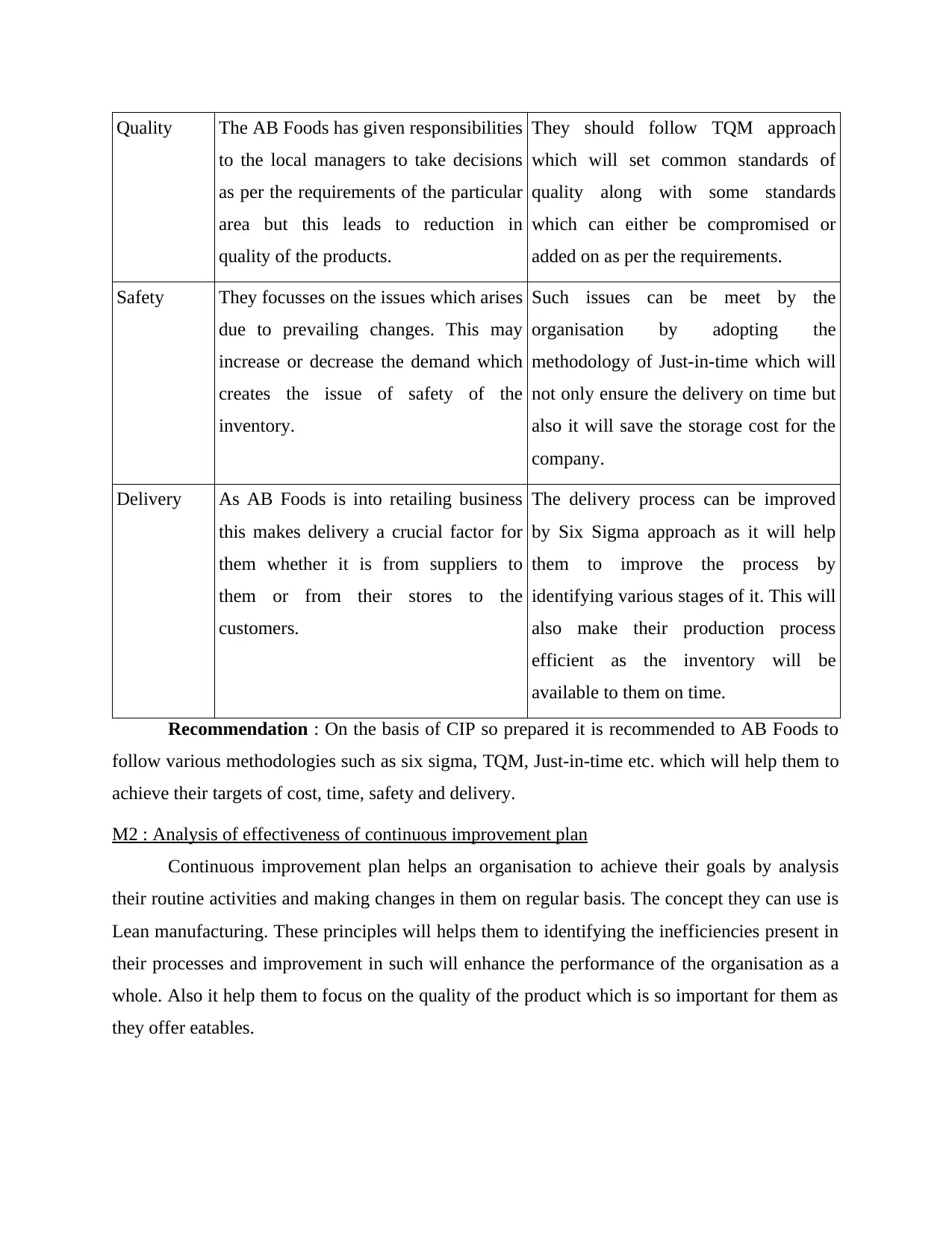
Quality The AB Foods has given responsibilities
to the local managers to take decisions
as per the requirements of the particular
area but this leads to reduction in
quality of the products.
They should follow TQM approach
which will set common standards of
quality along with some standards
which can either be compromised or
added on as per the requirements.
Safety They focusses on the issues which arises
due to prevailing changes. This may
increase or decrease the demand which
creates the issue of safety of the
inventory.
Such issues can be meet by the
organisation by adopting the
methodology of Just-in-time which will
not only ensure the delivery on time but
also it will save the storage cost for the
company.
Delivery As AB Foods is into retailing business
this makes delivery a crucial factor for
them whether it is from suppliers to
them or from their stores to the
customers.
The delivery process can be improved
by Six Sigma approach as it will help
them to improve the process by
identifying various stages of it. This will
also make their production process
efficient as the inventory will be
available to them on time.
Recommendation : On the basis of CIP so prepared it is recommended to AB Foods to
follow various methodologies such as six sigma, TQM, Just-in-time etc. which will help them to
achieve their targets of cost, time, safety and delivery.
M2 : Analysis of effectiveness of continuous improvement plan
Continuous improvement plan helps an organisation to achieve their goals by analysis
their routine activities and making changes in them on regular basis. The concept they can use is
Lean manufacturing. These principles will helps them to identifying the inefficiencies present in
their processes and improvement in such will enhance the performance of the organisation as a
whole. Also it help them to focus on the quality of the product which is so important for them as
they offer eatables.
to the local managers to take decisions
as per the requirements of the particular
area but this leads to reduction in
quality of the products.
They should follow TQM approach
which will set common standards of
quality along with some standards
which can either be compromised or
added on as per the requirements.
Safety They focusses on the issues which arises
due to prevailing changes. This may
increase or decrease the demand which
creates the issue of safety of the
inventory.
Such issues can be meet by the
organisation by adopting the
methodology of Just-in-time which will
not only ensure the delivery on time but
also it will save the storage cost for the
company.
Delivery As AB Foods is into retailing business
this makes delivery a crucial factor for
them whether it is from suppliers to
them or from their stores to the
customers.
The delivery process can be improved
by Six Sigma approach as it will help
them to improve the process by
identifying various stages of it. This will
also make their production process
efficient as the inventory will be
available to them on time.
Recommendation : On the basis of CIP so prepared it is recommended to AB Foods to
follow various methodologies such as six sigma, TQM, Just-in-time etc. which will help them to
achieve their targets of cost, time, safety and delivery.
M2 : Analysis of effectiveness of continuous improvement plan
Continuous improvement plan helps an organisation to achieve their goals by analysis
their routine activities and making changes in them on regular basis. The concept they can use is
Lean manufacturing. These principles will helps them to identifying the inefficiencies present in
their processes and improvement in such will enhance the performance of the organisation as a
whole. Also it help them to focus on the quality of the product which is so important for them as
they offer eatables.
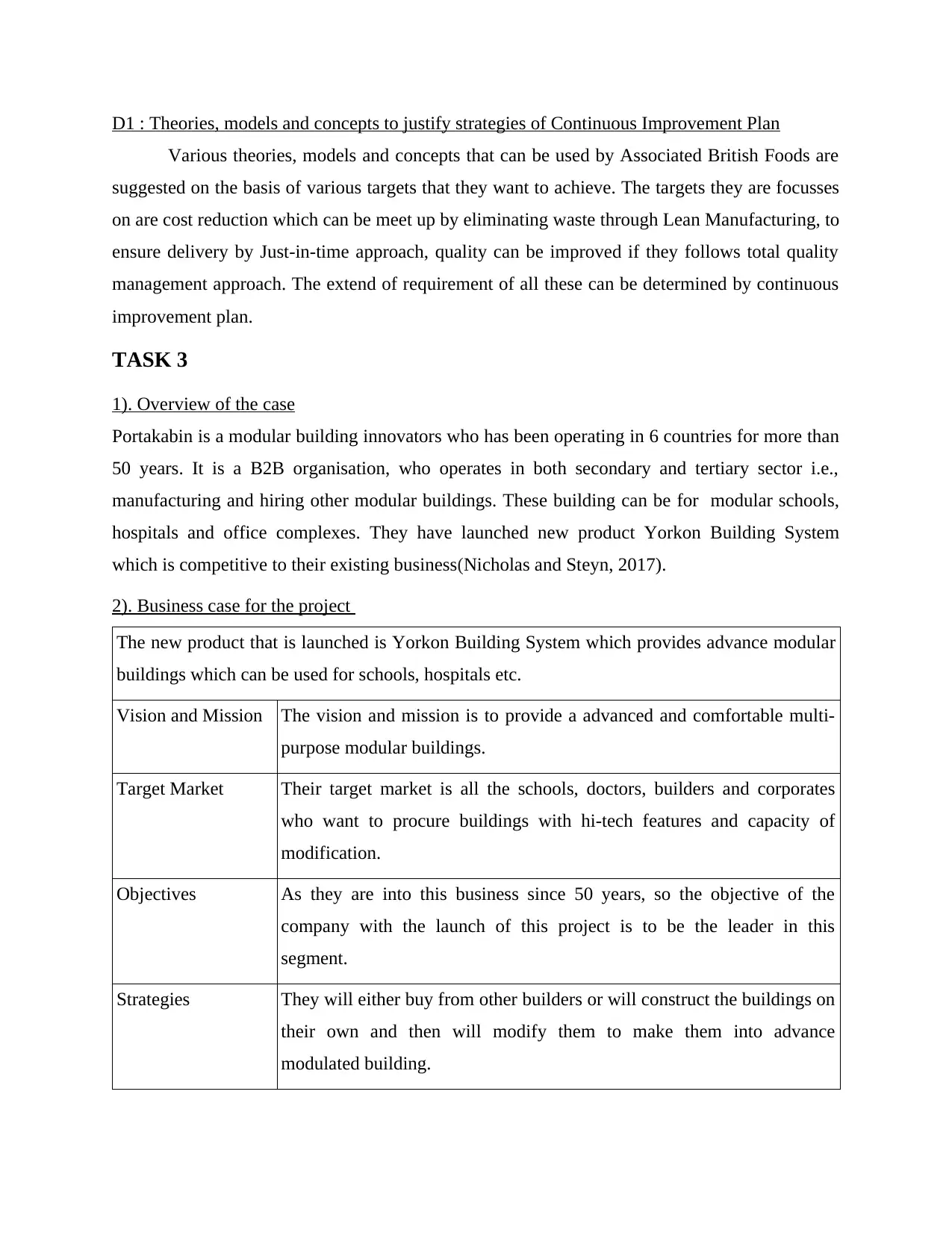
D1 : Theories, models and concepts to justify strategies of Continuous Improvement Plan
Various theories, models and concepts that can be used by Associated British Foods are
suggested on the basis of various targets that they want to achieve. The targets they are focusses
on are cost reduction which can be meet up by eliminating waste through Lean Manufacturing, to
ensure delivery by Just-in-time approach, quality can be improved if they follows total quality
management approach. The extend of requirement of all these can be determined by continuous
improvement plan.
TASK 3
1). Overview of the case
Portakabin is a modular building innovators who has been operating in 6 countries for more than
50 years. It is a B2B organisation, who operates in both secondary and tertiary sector i.e.,
manufacturing and hiring other modular buildings. These building can be for modular schools,
hospitals and office complexes. They have launched new product Yorkon Building System
which is competitive to their existing business(Nicholas and Steyn, 2017).
2). Business case for the project
The new product that is launched is Yorkon Building System which provides advance modular
buildings which can be used for schools, hospitals etc.
Vision and Mission The vision and mission is to provide a advanced and comfortable multi-
purpose modular buildings.
Target Market Their target market is all the schools, doctors, builders and corporates
who want to procure buildings with hi-tech features and capacity of
modification.
Objectives As they are into this business since 50 years, so the objective of the
company with the launch of this project is to be the leader in this
segment.
Strategies They will either buy from other builders or will construct the buildings on
their own and then will modify them to make them into advance
modulated building.
Various theories, models and concepts that can be used by Associated British Foods are
suggested on the basis of various targets that they want to achieve. The targets they are focusses
on are cost reduction which can be meet up by eliminating waste through Lean Manufacturing, to
ensure delivery by Just-in-time approach, quality can be improved if they follows total quality
management approach. The extend of requirement of all these can be determined by continuous
improvement plan.
TASK 3
1). Overview of the case
Portakabin is a modular building innovators who has been operating in 6 countries for more than
50 years. It is a B2B organisation, who operates in both secondary and tertiary sector i.e.,
manufacturing and hiring other modular buildings. These building can be for modular schools,
hospitals and office complexes. They have launched new product Yorkon Building System
which is competitive to their existing business(Nicholas and Steyn, 2017).
2). Business case for the project
The new product that is launched is Yorkon Building System which provides advance modular
buildings which can be used for schools, hospitals etc.
Vision and Mission The vision and mission is to provide a advanced and comfortable multi-
purpose modular buildings.
Target Market Their target market is all the schools, doctors, builders and corporates
who want to procure buildings with hi-tech features and capacity of
modification.
Objectives As they are into this business since 50 years, so the objective of the
company with the launch of this project is to be the leader in this
segment.
Strategies They will either buy from other builders or will construct the buildings on
their own and then will modify them to make them into advance
modulated building.
⊘ This is a preview!⊘
Do you want full access?
Subscribe today to unlock all pages.

Trusted by 1+ million students worldwide
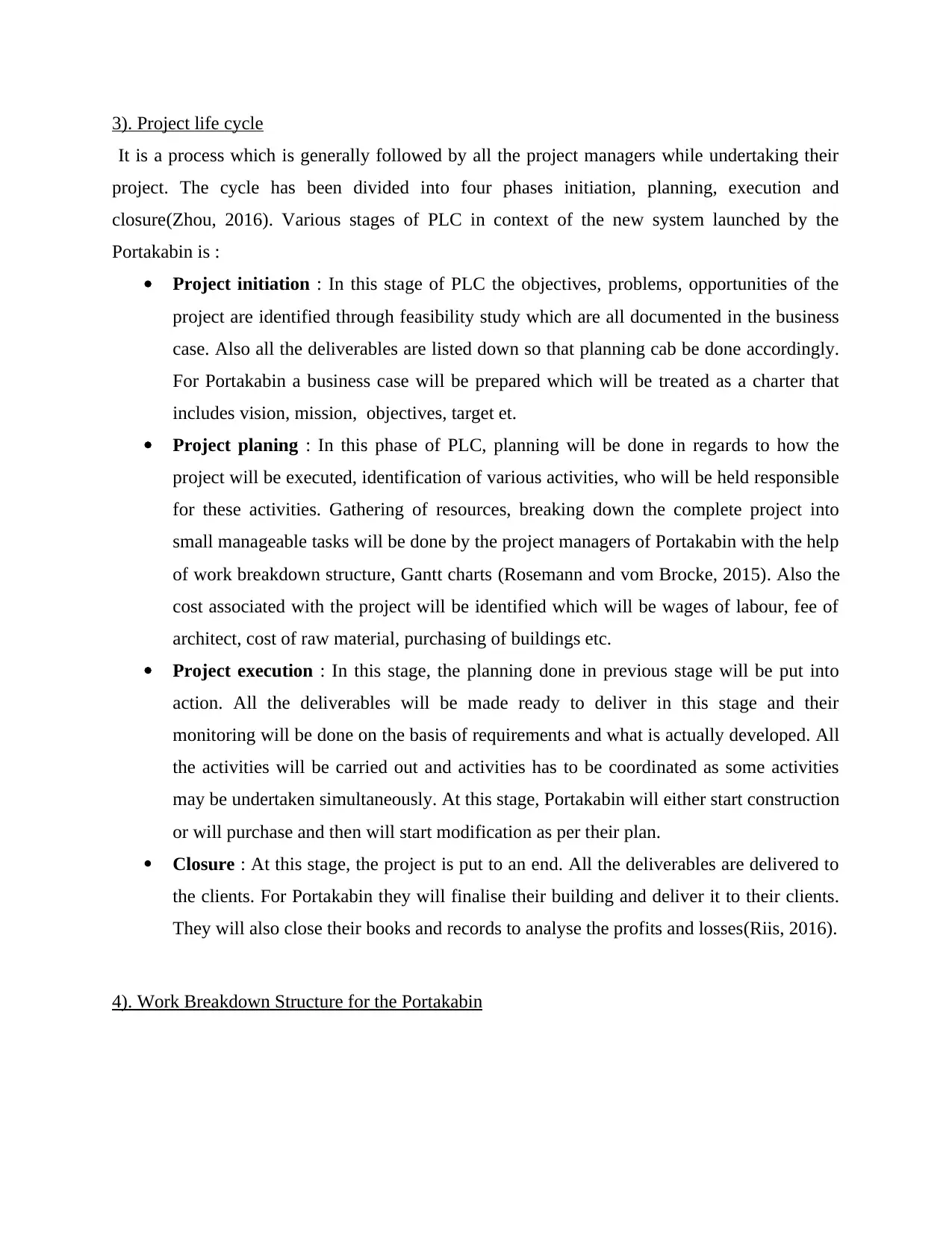
3). Project life cycle
It is a process which is generally followed by all the project managers while undertaking their
project. The cycle has been divided into four phases initiation, planning, execution and
closure(Zhou, 2016). Various stages of PLC in context of the new system launched by the
Portakabin is :
Project initiation : In this stage of PLC the objectives, problems, opportunities of the
project are identified through feasibility study which are all documented in the business
case. Also all the deliverables are listed down so that planning cab be done accordingly.
For Portakabin a business case will be prepared which will be treated as a charter that
includes vision, mission, objectives, target et.
Project planing : In this phase of PLC, planning will be done in regards to how the
project will be executed, identification of various activities, who will be held responsible
for these activities. Gathering of resources, breaking down the complete project into
small manageable tasks will be done by the project managers of Portakabin with the help
of work breakdown structure, Gantt charts (Rosemann and vom Brocke, 2015). Also the
cost associated with the project will be identified which will be wages of labour, fee of
architect, cost of raw material, purchasing of buildings etc.
Project execution : In this stage, the planning done in previous stage will be put into
action. All the deliverables will be made ready to deliver in this stage and their
monitoring will be done on the basis of requirements and what is actually developed. All
the activities will be carried out and activities has to be coordinated as some activities
may be undertaken simultaneously. At this stage, Portakabin will either start construction
or will purchase and then will start modification as per their plan.
Closure : At this stage, the project is put to an end. All the deliverables are delivered to
the clients. For Portakabin they will finalise their building and deliver it to their clients.
They will also close their books and records to analyse the profits and losses(Riis, 2016).
4). Work Breakdown Structure for the Portakabin
It is a process which is generally followed by all the project managers while undertaking their
project. The cycle has been divided into four phases initiation, planning, execution and
closure(Zhou, 2016). Various stages of PLC in context of the new system launched by the
Portakabin is :
Project initiation : In this stage of PLC the objectives, problems, opportunities of the
project are identified through feasibility study which are all documented in the business
case. Also all the deliverables are listed down so that planning cab be done accordingly.
For Portakabin a business case will be prepared which will be treated as a charter that
includes vision, mission, objectives, target et.
Project planing : In this phase of PLC, planning will be done in regards to how the
project will be executed, identification of various activities, who will be held responsible
for these activities. Gathering of resources, breaking down the complete project into
small manageable tasks will be done by the project managers of Portakabin with the help
of work breakdown structure, Gantt charts (Rosemann and vom Brocke, 2015). Also the
cost associated with the project will be identified which will be wages of labour, fee of
architect, cost of raw material, purchasing of buildings etc.
Project execution : In this stage, the planning done in previous stage will be put into
action. All the deliverables will be made ready to deliver in this stage and their
monitoring will be done on the basis of requirements and what is actually developed. All
the activities will be carried out and activities has to be coordinated as some activities
may be undertaken simultaneously. At this stage, Portakabin will either start construction
or will purchase and then will start modification as per their plan.
Closure : At this stage, the project is put to an end. All the deliverables are delivered to
the clients. For Portakabin they will finalise their building and deliver it to their clients.
They will also close their books and records to analyse the profits and losses(Riis, 2016).
4). Work Breakdown Structure for the Portakabin
Paraphrase This Document
Need a fresh take? Get an instant paraphrase of this document with our AI Paraphraser
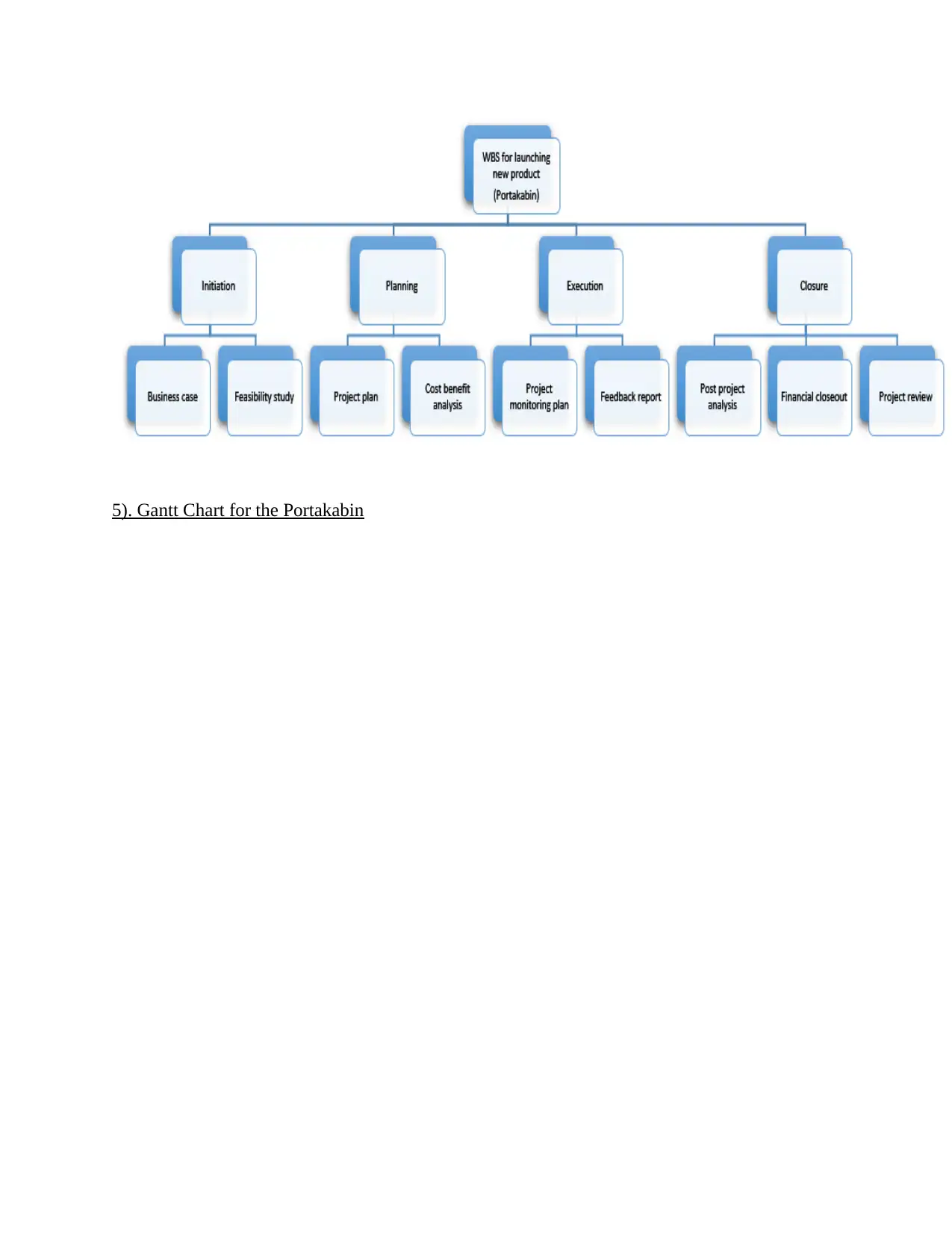
5). Gantt Chart for the Portakabin
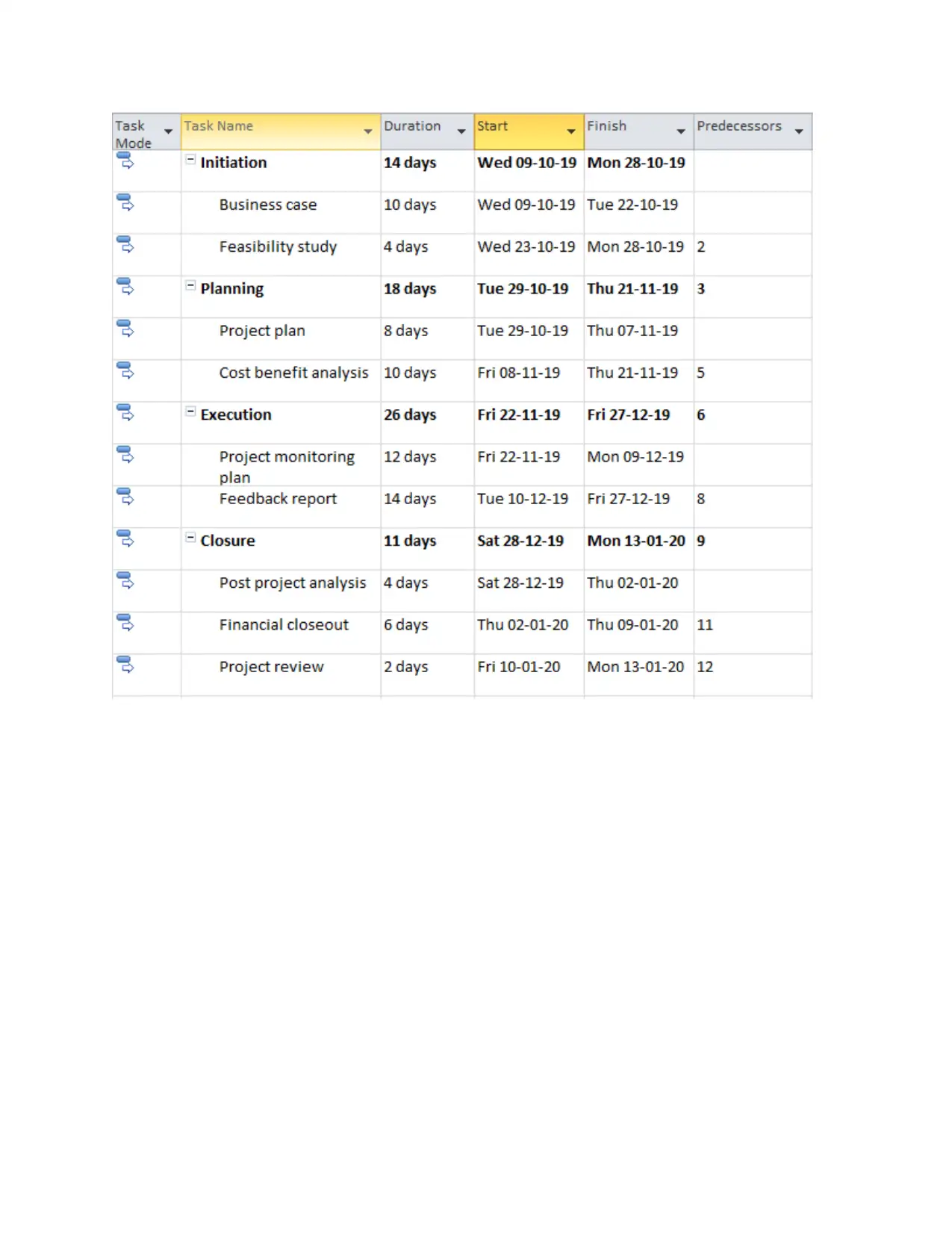
⊘ This is a preview!⊘
Do you want full access?
Subscribe today to unlock all pages.

Trusted by 1+ million students worldwide
1 out of 17
Related Documents
Your All-in-One AI-Powered Toolkit for Academic Success.
+13062052269
info@desklib.com
Available 24*7 on WhatsApp / Email
![[object Object]](/_next/static/media/star-bottom.7253800d.svg)
Unlock your academic potential
Copyright © 2020–2025 A2Z Services. All Rights Reserved. Developed and managed by ZUCOL.





